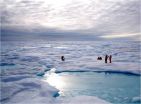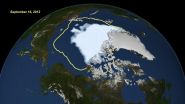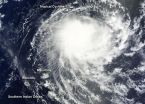(Press-News.org) "We have not seen an ice free period in the Arctic Ocean for 2,6 million years. However, we may see it in our lifetime." says marine geologist Jochen Knies. In an international collaborative project, Knies has studied the historic emergence of the ice in the Arctic Ocean. The results are published in Nature Communications.
The extent of sea ice cover in Arctic was much less than it is today between four and five million years ago. The maximum winter extent did not reaching its current location until around 2.6 million years ago. This new knowledge can now be used to improve future climate models.
"We have not seen an ice free period in the Arctic Ocean for 2,6 million years. However, we may see it in our lifetime. The new IPCC report shows that the expanse of the Arctic ice cover has been quickly shrinking since the 70-ies, with 2012 being the year of the sea ice minimum", Jochen Knies.
He is a research scientist at the Geological Survey of Norway (NGU) and Centre for Arctic Gas Hydrate, Environment and Climate (CAGE) at UiT The Arctic University of Norway.
In an international collaborative project, Jochen Knies has studied the trend in the sea ice extent in the Arctic Ocean from 5.3 to 2.6 million years ago. That was the last time the Earth experienced a long period with a climate that, on average, was warm before cold ice ages began to alternate with mild interglacials.
Fossils reveal past sea ice extent
"When we studied molecules from certain plant fossils preserved in sediments at the bottom of the ocean, we found that large expanses of the Arctic Ocean were free of sea ice until four million years ago," Knies tells us.
"Later, the sea ice gradually expanded from the very high Arctic before reaching, for the first time, what we now see as the boundary of the winter ice around 2.6 million years ago ," says Jochen Knies, who is also attached to CAGE, the Centre for Arctic Gas Hydrate, Environment and Climate at the University of Tromsø, the Arctic University of Norway.
Arctic Ocean likely to be completely free of sea ice
The research is of great interest on the international stage because present-day global warming is strongly tied to a shrinking ice cover in the Arctic Ocean. By the end of the present century, the Arctic Ocean seems likely to be completely free of sea ice, especially in summer.
This may have major significance for the entire planet 's climate system . Polar oceans , their temperature and salinity, are important drivers for world ocean circulation that distributes heat in the oceans. It also affects the heat distribution in the atmosphere. Trying to anticipate future changes in this finely tuned system, is a priority for climate researchers. For that they use climate modeling , which relies on good data.
"Our results can be used as a tool in climate modelling to show us what kind of climate we can expect at the turn of the next century. There is no doubt that this will be one of many tools the UN Climate Panel will make use of, too. The extent of the ice in the Arctic has always been very uncertain but, through this work, we show how the sea ice in the Arctic Ocean developed before all the land-based ice masses in the Northern Hemisphere were established," Jochen Knies explains.
Seabed samples from Spitsbergen
A deep well into the ocean floor northwest of Spitsbergen was the basis for this research. It was drilled as part of the International Ocean Drilling Programme, (IODP), to determine the age of the ocean-floor sediments in the area. Then, by analysing the sediments for chemical fossils made by certain microscopic plants that live in sea ice and the surrounding oceans, Knies and his co-workers were able to fingerprint the environmental conditions as they changed through time.
"One thing these layers of sediment enable us to do is to "read" when the sea ice reached that precise point," Jochen Knies tells us.
The scientists believe that the growth of sea ice until 2.6 million years ago was partly due to the considerable exhumation of the land masses in the circum-Arctic that occurred during this period. "Significant changes in altitudes above sea level in several parts of the Arctic, including Svalbard and Greenland, with build-up of ice on land, stimulated the distribution of the sea ice," Jochen Knies says.
"In addition, the opening of the Bering Strait between America and Russia and the closure of the Panama Cannel in central America at the same time resulted in a huge supply of fresh water to the Arctic, which also led to the formation of more sea ice in the Arctic Ocean," Jochen Knies adds.
All the large ice sheets in the Northern Hemisphere existed around 2.6 million years ago.
INFORMATION:
International effort
Scientists at CAGE, UiT The Arctic University of Norway, NGU, University of Plymouth, Universitat Autònoma de Barcelona, Stellenbosch University in South Africa and Institució Catalana de Recerca i Estudis Avançats in Barcelona have collaborated in this work.
The results of this new study are published in Nature Communications.
Reference
Nature Communications, 5: The emergence of modern sea ice cover in the Arctic Ocean.
Jochen Knies, Patricia Cabedo-Sanz, Simon T. Belt, Soma Baranwal, Susanne Fietz, Antoni Rosell-Melé.
This news release is available in German. FRANKFURT The chances of patients with Philadelphia chromosome-positive leukaemia (Ph+) being cured has greatly increased in recent years. Nevertheless, a high percentage of patients have developed resistance to available medication. But now, haematologists from Frankfurt, working with a Russian pharmaceutical company, have developed a new active substance that effectively combats the most aggressive forms of Philadelphia chromosome-positive leukaemia, both in vitro and in vivo. They have reported this in the current edition ...
Tropical Depression 21W crossed the Philippines and moved into the South China Sea where warm waters helped strengthen the storm into Tropical Storm Sinlaku. NASA's Aqua satellite passed over the storm and captured an image that showed it appeared elongated.
Despite the strengthening of Tropical Depression 21W into a tropical storm on Nov. 28, it appeared elongated from southwest to northeast on visible imagery taken by the Moderate Resolution Imaging Spectroradiometer (MODIS) instrument that flies aboard Aqua. The MODIS image also showed that the strongest thunderstorms ...
NASA's Terra satellite passed over Tropical Cyclone 02S after it formed in the Southern Indian Ocean on Nov. 28. An image from Terra showed that the new tropical storm is close to Mauritius and Reunion Islands.
The Moderate Resolution Imaging Spectroradiometer or MODIS instrument aboard NASA's Terra satellite captured a visible image of newborn Tropical Cyclone 02S northeast of the islands of Mauritius and Reunion. The MODIS image showed that thunderstorms were mostly west of the low-level center of circulation and bands of thunderstorms were wrapping into the center. ...
This news release is available in German. Humans don't like being alone, and their genes are no different. Together we are stronger, and the two versions of a gene - one from each parent - need each other. Scientists at the Max Planck Institute for Molecular Genetics in Berlin have analysed the genetic makeup of several hundred people and decoded the genetic information on the two sets of chromosomes separately. In this relatively small group alone they found millions of different gene forms. The results also show that genetic mutations do not occur randomly in the ...
Two physicists from the University of Warwick have taken to the kitchen to explain the complexity surrounding what they say is one of the last big mysteries in polymer physics.
As a way of demonstrating the complicated shapes that ring-shaped polymers can adopt, the researchers have created a brand new type of ring-shaped pasta, dubbed "anelloni" (anello being the Italian word for "ring"), which they've exclusively unveiled in this month's Physics World.
With just 2 eggs and 200 g of plain flour, Davide Michieletto and Matthew S Turner have created large loops of pasta ...
Peter Friedl, M.D., Ph.D., professor of genitourinary medical oncology at The University of Texas MD Anderson Cancer Center, has received one of Italy's top scientific awards for his work in imaging and cancer growth, metastasis and therapy response.
Friedl was named a recipient of the 13th annual City of Florence Prize in Molecular Sciences. Previous recipients include such scientific luminaries as AIDS research pioneer Robert C. Gallo. M.D., human genome sequencing expert J. Craig Venter, Ph.D., and Nobel laureates Robert Hubert, Ph.D. and Ada Yonath, Ph.D. Friedl received ...
Replenishing the supply of a molecule that normally activates cannabinoid receptors in the brain could relieve mood and anxiety disorders and enable some people to quit using marijuana, a Vanderbilt University study suggests.
Cannabinoid receptors are normally activated by compounds in the brain called endocannabinoids, the most abundant of which is 2-AG. They also are "turned on" by the active ingredient in marijuana.
Sachin Patel, M.D., Ph.D., and his colleagues developed a genetically modified mouse with impaired ability to produce 2-AG in the brain. The mice exhibited ...
This research is being carried out under the auspices of MAGDRIVE, a European research project coordinated by Professor José Luis Pérez Díaz, from the UC3M Instituto Pedro San Juan de Lastanosa, in which seven European entities participate. It consists of the development of a magnetic gear reducer, that is, a mechanism that transforms speed from an input axle to another in an output axle (as in a bicycle chain mechanism or the gearbox of an automobile). But in this case, unlike a conventional gear reducer, this transmission is produced without contact between ...
Astronomers have measured the passing of a super-Earth in front of a bright, nearby Sun-like star using a ground-based telescope for the first time. The transit of the exoplanet 55 Cancri e is the shallowest detected from the ground yet. Since detecting a transit is the first step in analyzing a planet's atmosphere, this success bodes well for characterizing the many small planets that upcoming space missions are expected to discover in the next few years.
The international research team used the 2.5-meter Nordic Optical Telescope on the island of La Palma, Spain, a moderate-sized ...
December 1, 2014 - A study using intricate fiber dissection techniques provides new insights into the deep anatomy of the human brainstem--and helps to define "safe entry zones" for neurosurgeons performing brainstem surgery, according to a special article published in Operative Neurosurgery, a quarterly supplement to Neurosurgery, official journal of the Congress of Neurological Surgeons. These publications are published by Lippincott Williams & Wilkins, a part of Wolters Kluwer Health.
Neurosurgeons Dr. Kaan Yagmurlu and Dr. Albert L. Rhoton, Jr, of University of Florida, ...







